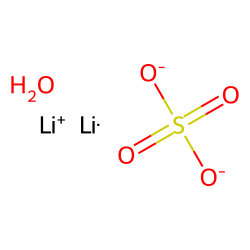Similar Compounds
Find more compounds similar to Lithium sulfate.
Mixtures
- Water + Lithium sulfate
- Ethanol + Water + Lithium sulfate
- 1-Propanol + Water + Lithium sulfate
- lithium chloride + Water + Lithium sulfate
- Sodium sulfate + Water + Lithium sulfate
- Water + Lithium sulfate + Potassium sulfate
- Water + Lithium sulfate + lithium carbonate
- Sucrose + Water + Lithium sulfate
- 2,3-Butanediol + Water + Lithium sulfate
- Boric acid + Water + Lithium sulfate
- Isopropyl Alcohol + Water + Lithium sulfate
- Methyl Isobutyl Ketone + Water + Lithium sulfate
- 1-Butanol + Water + Lithium sulfate
- Acetone + Water + Lithium sulfate
Sources
- Study of the liquid-liquid equilibrium of 1-propanol + manganese sulphate and 2-propanol + lithium sulphate aqueous two-phase systems at different temperatures: Experiment and correlation
- Solid-liquid phase equilibria in the aqueous ternary system Li2SO4 + LiBO2 + H2O at T = 288.15 and 298.15 K
- Experimental study of the density and derived partial molar volumes of complex ternary water+1-propanol+Li2SO4 mixtures at temperatures from (303 to 448) K and pressures up to 40 MPa
- Phase equilibria in the ternary system (LiCl + Li2SO4+H2O) at T = 308.15 K and p = 0.1MPa: Experimental data and predictions using the Pitzer model
- Stable phase equilibria in the ternary system (Na2SO4 + Li2SO4 + H2O) at 308.15 K and 313.15 K
- Solid-liquid metastable phase equilibria for the ternary system (Li2SO4 + K2SO4 + H2O) at 288.15 and 323.15 K and p = 0.1 MPa
- Salt influence on MIBK/water liquid-liquid equilibrium: Measuring and modeling with ePC-SAFT and COSMO-RS
- Influence of electrolytes on liquid-liquid equilibria of water/1-butanol and on the partitioning of 5-hydroxymethylfurfural in water/1-butanol
- Phase equilibria in the aqueous ternary systems (LiCl + LiBO2 + H2O) and (Li2SO4+ LiBO2 + H2O) at 323.15 K and 0.1 MPa
- Tuning physical properties and mesomorphic structures in aqueous 1-ethyl-3-methylimidazolium octylsulfate rigid-gel with univalent salt doping
- Mineral solubilities of salts in the three quaternary systems: LiCl-NaCl-MgCl2-H2O, LiCl-KCl-MgCl2-H2O and Li2SO4-K2SO4-MgSO4-H2O at 288.15 K
- Liquid-liquid equilibrium phase behavior of iminazolium-based ionic liquid aqueous two-phase systems composed of 1-alkyl-3-methyl imidazolium tetrafluoroborate and different electrolytes ZnSO4, MgSO4 and Li2SO4 at 298.15 K: Experimental and correlation
- Measurement and correlation of phase diagram data for acetone andsulfate aqueous two-phase systems at different temperatures
- Experimental determination and modeling of the solubility phase diagram of the ternary system (Li2SO4+K2SO4+H2O) at 288.15 K
- Phase Equilibria in the Ternary System (LiCl + Li2SO4 + H2O) at T = (288.15 and 308.15) K: Experimental Determination and Model Simulation
- Isopiestic Measurements of Water Activity for the Li2SO4 MgSO4 H2O System at 323.15 and 373.15 K
- Solubilities, Densities and Refractive Indices in the Aqueous Quaternary System of Lithium Sulfate, Lithium Metaborate, and Lithium Carbonate at 288.15, 298.15, 308.15 K and 0.1 MPa
- Phase Equilibria of Two Ternary Systems: Li2SO4 Li2B4O7 H2O and K2B4O7 K2SO4 H2O at 273 K
- Stable Phase Diagram of Quaternary Water-Salt System Li+, Na+, Cs+//SO42--H2O at T = 298.2 K
- Solubilities, Densities, Refractive Indices, and pH Values of the Aqueous Ternary Systems (LiCl + LiB5O8 + H2O) and (Li2SO4 + LiB5O8 + H2O) at 288.15 K and 101 kPa
- Stable Phase Equilibrium of the Quaternary System Li2SO4 + Cs2SO4 + MgSO4 + H2O at 298.2 K
- Measurement and Prediction of Solid + Liquid Equilibria in the Quaternary System LiCl-KCl-Li2SO4-K2SO4-H2O at 288.15 K
- Viscosity for Aqueous Li2SO4 Solutions at Temperatures from 298 to 575 K and at Pressures up to 30 MPa
- Densities of (Lithium, Magnesium, or Copper(II)) Sulfates in Ethanol-Water Solutions
- Densities, partial molar volumes at infinite dilution, side chain partial molar volumes and transfer volumes of dipeptides in sucrose and 2,3- butanediol aqueous solutions at T = (283.15 - 333.15) K
- Solubility, Density, Refractive Index, Viscosity, and Electrical Conductivity of Boric Acid + Lithium Sulfate + Water System at (293.15, 298.15, 303.15, 308.15 and 313.15) K
- Phase Equilibria and Phase Diagrams for the Aqueous Ternary System (Na2SO4 + Li2SO4 + H2O) at (288 and 308) K
- Solid Liquid Phase Equilibria in the Ternary Systems (LiCl + MgCl2 + H2O) and (Li2SO4 + MgSO4 + H2O) at 288.15 K
- Refractive Indices of Lithium, Magnesium, and Copper(II) Sulfates in Ethanol-Water Solutions
- NIST Webbook
Note: Cheméo is only indexing the data, follow the source links to retrieve the latest data. The source is also providing more information like the publication year, authors and more. Take the time to validate and double check the source of the data.
